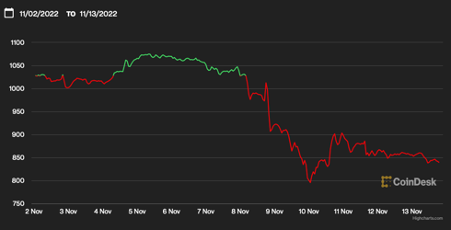FTX is going bankrupt, how this happened and what does it mean for crypto market?
/ by Raphael Ketterer | Leave a comment

What caused FTXs bankruptcy? This is a question that has been on the minds of many people since the company filed for bankruptcy November 11, 2022. While there are many factors that contributed to FTXs downfall, in this blog post we will focus on four main reasons: the decline in demand for FTXs products, the competition from other companies, the financial mismanagement of FTX, and the leaked CoinDesk balance sheet.
What is FTX ?
FTX is the third largest crypto exchange after Binance and Coinbase, a crypto exchange is web platform that allow people to buy, sell or trade cryptocurrencies as Bitcoin or Ethereum. It also allows its customer to bet on assets with leverage, acting as a broker company. FTX is an abbreviation for “Futures Exchange”. The company has been founded in 2019 by Sam Bankman-Fried (CEO) a former quantitative trader at Jane Street Capital. He was inspired to create the company after seeing the success of derivatives trading platforms like Binance and BitMEX. FTX quickly became one of the leading cryptocurrency derivatives exchanges, with over $1 billion in daily trading volume within its first year of operation. The company attracted customers with its innovative products, low fees, and user-friendly platform. In February, the company accounted over one million user, 2 billion turnover and 32 billion in valuation. The platform was recognized as truthful and stable firm in the crypto industry, a lot of investors choose it to place their money and use it to trade cryptocurrencies.
The early decline of FTX
In early 2022 FTX undergone a sudden and significant decline in demand for its products. This can be attributed to several factors, including the overall slowdown in the cryptocurrency market, as well as specific issues with FTX’s platform and product offerings. In particular, many users were unhappy with FTX’s decision to delist certain tokens, and there were also concerns about the security of the platform after a number of high-profile hacks. These factors led to a mass exodus of users from FTX, which in turn led to a sharp decline in revenues. Another contributing factor to FTX’s demise was the increasing competition from other exchanges and trading platforms. In particular, Binance, who bought 10% shares of FTX in 2020, had become a major player in the space, offering lower fees and a more user-friendly interface. This made it very difficult for FTX to attract new users and keep existing ones loyal.
What happened ?
In 2022, FTX filed for bankruptcy, this came as a shock to many in the industry, as FTX had been widely considered to be a successful and well-managed company up until that point.
FTX was poorly managed from a financial perspective. In particular, the company made some very risky bets on volatile cryptocurrencies, which ultimately backfired when prices crashed. This left FTX with substantial losses that it was unable to recover from. Indeed, A key factor that contributed to FTX’s bankruptcy was its heavy reliance on the value of its native token, FTT. Coindesk.com, a popular news website talking about crypto and blockchain, reported a leaked balance sheet from FTX: “FTT represented nearly 60% of FTX’s total assets at one point.” Meaning that clients deposits were mainly used to buy FTT, but the FTT price is very volatile and if user loose trust, that would have a profound impact on FTX’s bottom line.
Nov 2 to Nov 10 – The downfall
November 2, CoinDesk publish an alarming article
Alameda Research, the trading firm beyond FTX, have been victims of a leak of private financial data. The document has been communicated to CoinDesk which written an article about it. The article claim that Alameda biggest liquid asset is FTT, representing $3.4 billion. The article went viral on twitter.
SCOOP: Sam Bankman-Fried's @AlamedaResearch had $14.6 billion of assets as of June 30, according to a private document CoinDesk reviewed. Much of it is the $FTT token issued by @FTX_Official, another SBF company.@IanAllison123 reportshttps://t.co/9kigf7VXph
— CoinDesk (@CoinDesk) November 2, 2022
November 6, the CEO of Binance, CZ (Changpeng Zhao) Twitted that Binance will sell its assets of FTX tokens.
The CZ tweet created a panic on the crypto sphere, people were doubting about the security of their fund and of the FTX platform. A lot of FTT holder decided to sell their assets to buy stable coins. The CEO of Alameda Research, Caroline Ellis answered him that the firm will buy the token back for $22 per token (a little bit less than the market price at that moment). The point of the buyback was for reducing the FTT’s user fear.
As part of Binance’s exit from FTX equity last year, Binance received roughly $2.1 billion USD equivalent in cash (BUSD and FTT). Due to recent revelations that have came to light, we have decided to liquidate any remaining FTT on our books. 1/4
— CZ 🔶 Binance (@cz_binance) November 6, 2022
November 7, SBF (Sam Bankman-Fried or CEO of FTX), explained that all the assets are fine.
To stop the rumour that the user’s funds are not sure, SBF twitted that the assets are fine, and the client can withdraw their money if needed. He gave some details to prove that assets are not invested, and everything is 100% liquid. But it didn’t helped, FTT users withdraw $5b of their assets on the platform on Sunday November 6 making the token value decrease from $22 to $15 in only 3 hours. The SBF tweet has been deleted one day after while the FTT value went down making the user panicking even more.

1) I'm sorry. That's the biggest thing.
— SBF (@SBF_FTX) November 10, 2022
I fucked up, and should have done better.
November 9, Binance decide to refuse FTX offer.
Binance, the crypto exchange world leader and most trusted, considered in the past to buy its competitor, FTX. But after some due diligence and because of the rumors about FTX solvability, CZ announced that its company will not buy FTX. During the night between November 8 and 9, the FTX token went from $15 to $2.5 as many other user decided to sell their assets.
November 10, FTX assets are frozen by Bahamian Regulators, FTX stop accepting new users and stop any withdrawals request.
On that day, every person who have assets in the FTX exchange cannot ask for their money back, some users invested millions in the platform and cannot withdraw it. The Bahamian Regulators frozen the account of FTX international entity (as the US one is separated), the company cannot use their bank accounts anymore.
The aftermath of FTXs bankruptcy.
For customers
The bankruptcy of FTX had a significant impact on its employees. Many of them were laid off, and those who remained were often not paid their full salaries. This led to a lot of financial hardship for FTX’s employees.
For employees
FTX’s customers also faced difficulties after the company’s bankruptcy. Many of them were left with frozen balance on the platform, and some even lost money because of the decline in the value of FTT tokens. This resulted in a lot of customer dissatisfaction and frustration.
For the crypto market
The CoinDesk Market Index is based on 162 crypto asset’s values and is used to follow cryptocurrency’s value to give trend of the market. This index reported a drop of 20% in the whole market. In the future, the bankruptcy of FTX is likely to have a negative impact on the cryptocurrency market. This is because it will increase investor uncertainty and reduce confidence in the sector. Additionally, it may lead to more regulation being imposed on the industry, which could hamper innovation and growth.

Conclusion
The bankruptcy of FTX was a result of financial mismanagement. The impact of the bankruptcy has been felt by FTX’s employees and customers, and it remains to be seen how it will affect the cryptocurrency markets on the long term. Trust on centralized crypto exchanges is declining and people will go for more decentralized way to store their crypto in the future. For beginners, I would recommend installing software crypto wallets as Exodus or to buy a hardware wallet (cold storage). If you don’t lose the key, those solutions would be the most secure ones. The crypto market is volatile and no sure nowadays, waiting some time to invest more money can be a great idea.
Related articles
Buy our products !
References:
#https://twitter.com/CoinDesk
https://www.coindesk.com
https://ftx.com
https://www.cnbc.com/2022/11/15/ftx-says-could-have-over-1-million-creditors-in-new-bankruptcy-filing.html
https://www.forbes.com/advisor/investing/cryptocurrency/ftx-declares-bankruptcy/
https://www.wsj.com/articles/ftx-founder-sam-bankman-fried-attempts-to-raise-fresh-cash-despite-bankruptcy-11668520573
https://www.bbc.com/news/business-63601213










